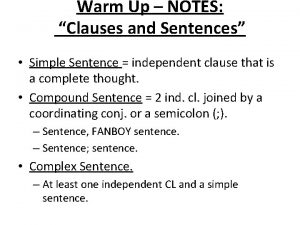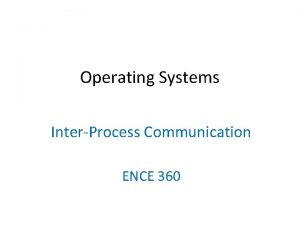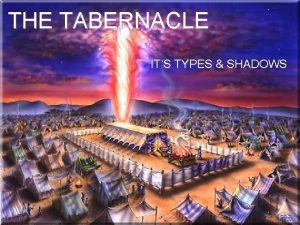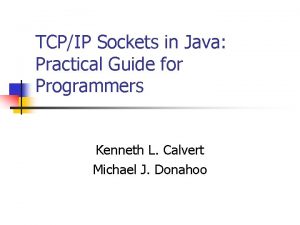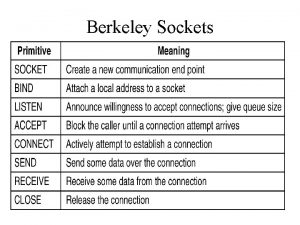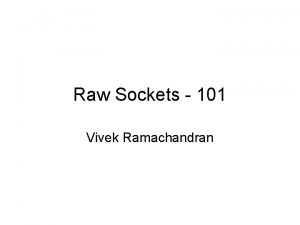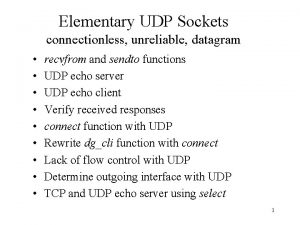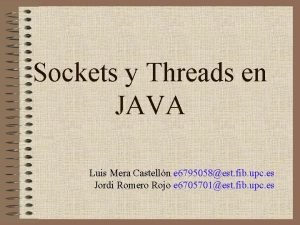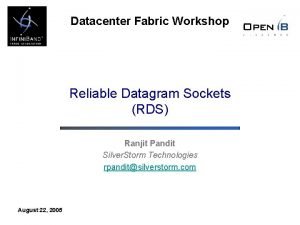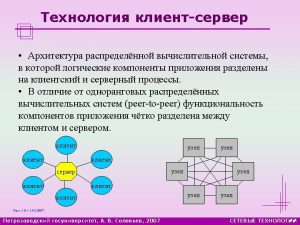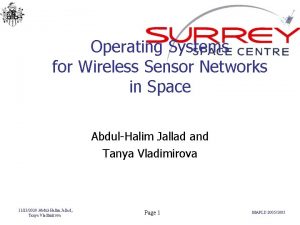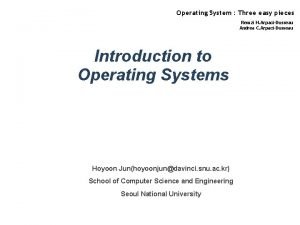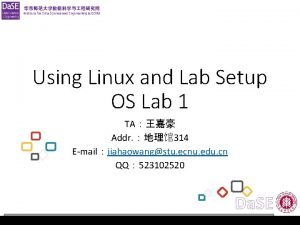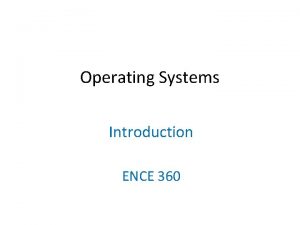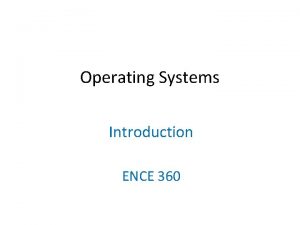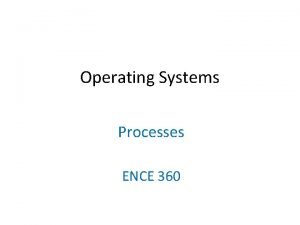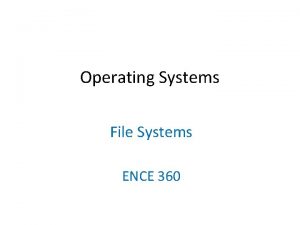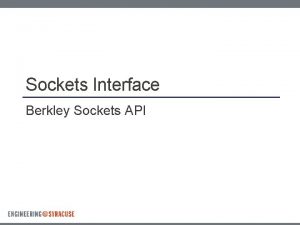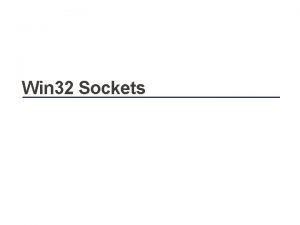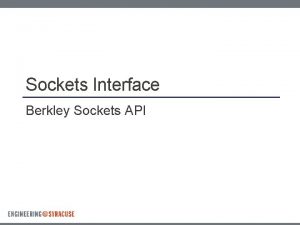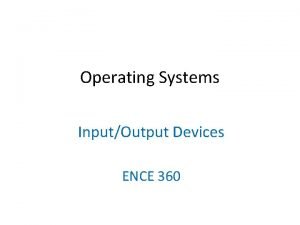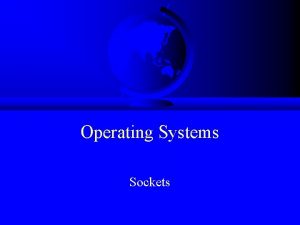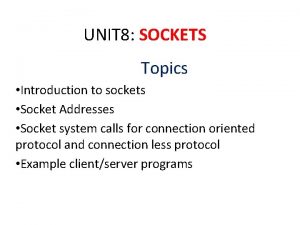Operating Systems Sockets ENCE 360 Outline Introduction Details






































- Slides: 38

Operating Systems Sockets ENCE 360

Outline • • Introduction Details Example code Socket options+

Socket Overview • Socket - An end-point for connection to another process (remote or local) – What application layer “plugs into” Protocol A Application Sockets Protocol B Protocol C Network • User sees descriptor - integer index/handle – Like: file index from open() – Returned by socket() call (more later) – Programmer cares about Application Programming Interface (API) similar to file I/O (TCP=Transport Control Protocol, IP=Internet Protocol)

Connection Endpoints • End point determined by two things: Sever – Host address: e. g. , IP address – Port number Client • Two end-points determine connection socket pair socket Port Connection any port agreed port socket message client server other ports Internet address = 138. 37. 94. 248 Internet address = 138. 37. 88. 249

port 0 Ports port 1 • Each host has 65, 536 ports port 65535 – 16 -bit integer • Some ports are reserved for specific apps (/etc/services) – FTP – Telnet – HTTP 20, 21 23 80 server • Ports below 1024 are reserved app • Ports 1024 -5000 ephemeral port client port app data – User level 1024+ – Assigned in outgoing connection • Ports 5001+ services app port Network Packet port data Packet

Two Main Network Transport Protocols Today • UDP: User Datagram Protocol – no acknowledgements – no retransmissions – out of order, duplicates possible – Connectionless – SOCK_DGRAM • TCP: Transmission Control Protocol – reliable (in order, all arrive, no duplicates) – flow control – connection-based TCP ~95% of all flows – SOCK_STREAM and packets on Internet (What applications may use UDP? ) Application (http, ftp, telnet, …) Transport (TCP, UDP, . . ) Network (IP, . . ) Link (device driver, . . ) More in a networks course!

Socket Descriptor Data Structure Descriptor Table 0 1 2 3 4 Socket Data Structure Family: Service: Local IP: Remote IP: Local Port: Remote Port: received queue Service is the Transport Protocol IP (Internet Protocol) - address of computer Port - specifies which process on computer PF_INET SOCK_STREAM 111. 22. 3. 4 123. 45. 6. 78 2249 3726 sent queue

Outline • • Introduction Details Example code Socket options+ Unix Network Programming, W. Richard Stevens, 2 nd edition, 1998, Prentice Hall (done) (next) Beej’s Guide to Network Programming, Brian Hall, 2015, self-published, http: //beej. us/guide/bgnet/

Addresses and Sockets • Structure to hold address information • Functions pass info (e. g. , address) from user to OS bind() connect() sendto() • Functions pass info (e. g. , address) from OS to user accept() recvfrom()

Socket Address Structure struct in_addr { in_addr_t s_addr; }; /* 32 -bit IPv 4 addresses */ struct sockaddr_in { unit 8_t sin_len; /* length of structure */ sa_family_t sin_family; /* AF_INET */ in_port_t sin_port; /* TCP/UDP port number */ struct in_addr sin_addr; /* IPv 4 address (above) */ char sin_zero[8]; /* unused */ }; Also “generic” and “IPv 6” socket structures

Server TCP Client-Server socket() bind() “well-known” port listen() Client accept() (Block until connection) socket() “Handshake” Data (request) recv() send() recv() close() connect() send() Data (reply) recv() End-of-File close()

socket() int socket(int family, int type, int protocol); Create socket, giving access to transport layer service • family is one of – AF_INET (IPv 4), AF_INET 6 (IPv 6), AF_LOCAL (local Unix), – AF_ROUTE (access to routing tables), AF_KEY (for encryption) • type is one of – SOCK_STREAM (TCP), SOCK_DGRAM (UDP) – SOCK_RAW (for special IP packets, PING, etc. Must be root) • setuid bit (-rwsr-xr-x root 2014 /sbin/ping*) • protocol is 0 (used for some raw socket options) • upon success returns socket descriptor – Integer, like file descriptor index used internally – Return -1 if failure

bind() int bind(int sockfd, const struct sockaddr *myaddr, socklen_t addrlen); Assign local protocol address (“name”) to socket • sockfd is socket descriptor from socket() • myaddr is pointer to address struct with: – port number and IP address – if port is 0, then host will pick ephemeral port • not usually for server (exception RPC port-map) – IP address == INADDR_ANY (unless multiple nics) • addrlen is length of structure • returns 0 if ok, -1 on error – EADDRINUSE (“Address already in use”)

listen() int listen(int sockfd, int backlog); Change socket state (to passive) for TCP server • sockfd is socket descriptor from socket() • backlog is maximum number of incomplete connections – historically 5 – rarely above 15 even on moderately busy Web server! • sockets default to active (for client) – change to passive so OS will accept connection

accept() int accept(int sockfd, struct sockaddr * cliaddr, socklen_t *addrlen); Return next completed connection • blocking call (by default) • sockfd is socket descriptor from socket() • cliaddr and addrlen return protocol address from client • returns brand new descriptor, created by OS • note, if create new process or thread, can create concurrent server

close() int close(int sockfd); Close socket for use • sockfd is socket descriptor from socket() • closes socket for reading/writing – returns (doesn’t block) – attempts to send any unsent data – socket option SO_LINGER • block until data sent • or discard any remaining data – returns -1 if error

Server TCP Client-Server socket() bind() “well-known” port listen() Client accept() (Block until connection) socket() “Handshake” Data (request) recv() send() recv() close() connect() send() Data (reply) recv() End-of-File close()

connect() int connect(int sockfd, const struct sockaddr *servaddr, socklen_t addrlen); Connect to server • sockfd is socket descriptor from socket() • servaddr is pointer to structure with: – port number and IP address – must be specified (unlike bind()) • addrlen is length of structure • client doesn’t need bind() – OS will pick ephemeral port • returns socket descriptor if ok, -1 on error

Sending and Receiving int recv(int sockfd, void *buff, size_t mbytes, int flags); int send(int sockfd, void *buff, size_t mbytes, int flags); • Same as read() and write() but with flags – – – MSG_DONTWAIT (this send non-blocking) MSG_OOB (out of band data, 1 byte sent ahead) MSG_PEEK (look, but don’t remove) MSG_WAITALL (don’t return less than mbytes) MSG_DONTROUTE (bypass routing table)

Server UDP Client-Server socket() bind() “well-known” port Client recvfrom() socket() (Block until receive datagram) Data (request) sendto() recvfrom() Data (reply) close() - No “connection”, no “handshake” - No simultaneous close

Sending and Receiving int recvfrom(int sockfd, void *buff, size_t mbytes, int flags, struct sockaddr *from, socklen_t *addrlen); int sendto(int sockfd, void *buff, size_t mbytes, int flags, const struct sockaddr *to, socklen_t addrlen); • Same as recv() and send() but with addr – recvfrom fills in address of where packet came from – sendto requires address of where sending packet to

Can connect() with UDP • Record address and port of peer – Datagrams to/from others are not allowed – Does not do three way handshake, or connection – So, “connect” a misnomer, here. Should be setpeername() • Use send() instead of sendto() • Use recv() instead of recvfrom() • Can change connect or unconnect by repeating connect() call • (Can do similar with bind() on receiver)

Outline • • Introduction Details Example code Socket options+ (done) (next)

Example Code Server % listen-tcp 1 listen-tcp - server to accept TCP connections usage: listen-tcp <port> - port to listen on % listen-tcp 7500 2 Listen activating. Trying to create socket at port 7500. . . Socket ready to go! Accepting connections. . received: 'Hello, world!' received: 'Networking is awesome!' server exiting See: “listen-tcp. c” “talk-tcp. c” Client 3 % talk-tcp - client to try TCP connection to server usage: talk-tcp <host> <port> <host> - Internet name of server host <port> - port % talk-tcp localhost 7500 4 Talk activated. Trying to connect to server localhost at port 7500. . . Looking up localhost. . . Found it. Setting port connection to 7500. . . Done. Creating socket. . . Created. Trying connection to server. . . Connection established! Type in messages to send to server. Hello, world! sending: 'Hello, world!' Networking is awesome! sending: 'Networking is awesome!'

Outline • • Introduction Details Example code Socket options+ (done) (next)

Socket Options (General) • setsockopt(), getsockopt() • SO_LINGER – Upon close, discard data or block until sent • SO_RCVBUF, SO_SNDBUF – Change buffer sizes – For TCP is “pipeline”, for UDP is “discard” • SO_RCVLOWAT, SO_SNDLOWAT – How much data before “readable” via select() • SO_RCVTIMEO, SO_SNDTIMEO – Timeouts

Socket Options (TCP) • TCP_KEEPALIVE – Idle time before close (2 hours, default) • TCP_MAXRT – Set timeout value • TCP_NODELAY – Disable Nagle’s Algorithm – Won’t buffer data for larger chunk, but sends immediately

fcntl() • ‘File control’ - manipulate file descriptor – So, used for sockets, too • Get/Set socket owner • Get/Set socket lock • Set socket non-blocking flags = fcntl(sockfd, F_GETFL, 0); flags |= O_NONBLOCK; fcntl(sockfd, F_SETFL, flags); • Beware not getting flags before setting!

Connecting to the Internet • If one computer, connect to server?

Internet Connecting to You • If one computer, connect to server? • Server connect to your computer?

Firewall to the Rescue! Close all ports! Note: even if no services (processes), OS response still gives information to hackers! (“fingerprint”)

Firewall Too Restrictive Close all ports! Note: even if no services (processes), OS response still gives information to hackers! (“fingerprint”) • What if want connection? (Examples? )

Firewall – Port Forwarding Close all ports! Note: even if no services (processes), OS response still gives information to hackers! (“fingerprint”) • What if want connection? (Examples? ) Open port. Aka: port forwarding

Connecting to the Internet, Take 2 • Single address, multiple computers? 104. 45. 147. 81 (World) 202. 36. 179. 10 ? (Home)

Connecting to the Internet, Take 2 • Single address, multiple computers? – Assign one box to route packets to all • But how to differentiate incoming? 104. 45. 147. 81 (World) 202. 36. 179. 10 192. 168. 1. 1 ? (Home) 192. 168. 1. 2 192. 168. 1. 4 192. 168. 1. 3

Network Address Translation (NAT) • Single address, multiple computers? – Assign one box to route packets to all • But how to differentiate incoming? – Based on port – Setup when connecting Network Address Translation 104. 45. 147. 81 80 (World) 202. 36. 179. 10 192. 168. 1. 1 9991 192. 168. 1. 2 (Home) 192. 168. 1. 2 192. 168. 1. 4 192. 168. 1. 3

NAT Tables https: //microchip. wdfiles. com/local--files/tcpip: nat-translation-table/nat_table. JPG • Table maps local IP + port to Internet IP + port • Setup when connected by client (punch out) • Pre-setup by administrator when connecting in (local service/server)

Outline • • Introduction Details Example code Socket options+ (done)
 Aaawwubbis
Aaawwubbis Simple sentence notes
Simple sentence notes Comma causers
Comma causers Electric potential
Electric potential Ence storage
Ence storage Ence pipes
Ence pipes Easy for ence
Easy for ence Introduction to operating systems
Introduction to operating systems Minor details examples
Minor details examples Signal words
Signal words Supporting detail 1
Supporting detail 1 Main idea and supporting details examples
Main idea and supporting details examples Concept map main idea supporting details
Concept map main idea supporting details Sockets of the tabernacle
Sockets of the tabernacle Tcp ip sockets in c
Tcp ip sockets in c Tcp/ip sockets in java: practical guide for programmers
Tcp/ip sockets in java: practical guide for programmers Automotive steering systems
Automotive steering systems Sockets direct protocol
Sockets direct protocol Berkley sockets
Berkley sockets Reliable datagram sockets
Reliable datagram sockets Unix network programming stevens
Unix network programming stevens What are raw sockets
What are raw sockets D3azeg_clwi -site:youtube.com
D3azeg_clwi -site:youtube.com Sockets and threads
Sockets and threads Cleanroom 380v sockets
Cleanroom 380v sockets R sockets
R sockets Tanenbaum linux
Tanenbaum linux Secure sockets
Secure sockets Tcp/ip sockets in c
Tcp/ip sockets in c Reliable datagram sockets
Reliable datagram sockets Berkeley sockets
Berkeley sockets Quotation sandwich example
Quotation sandwich example Examples of operating system
Examples of operating system Evolution of operating systems
Evolution of operating systems Components of an operating system
Components of an operating system User view and system view in os
User view and system view in os Wsn operating systems
Wsn operating systems Operating systems tree
Operating systems tree Operating systems lab
Operating systems lab

